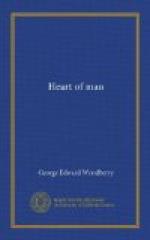It thus appears more and more that art is educative; it is the race’s foreknowledge of what may be, of the objects of effort and the methods of their attainment under mortal conditions. The difficulty of men in respect to it is the lax power they have to see in it the truth, as contradistinguished from the fact, the continuous reality of the things of the mind in opposition to the accidental and partial reality of the things of actuality. They think of it as an imagined, instead of as the real world, the model of that which is in the evolution of that which ought to be. In history the climaxes of art have always outrun human realization; its crests in Greece, Italy, and England are crests of the never-attained; but they still make on in their mass to the yet rising wave, which shall be of mankind universal, if, indeed, in the cosmopolitan civilization which we hope for, the elements of the past, yet surviving from the accomplishment of single famous cities and great empires, shall be blended in a world-ideal, expressing the spiritual uplifting to God of the reconciled and unified nations of the earth.
There remains but one last resort; for it will yet be urged that the impossibility of any scientific knowledge of the spiritual order is proved by the transience of the ideals of the past; one is displaced by another, there is no permanence in them. It is true that the concrete world, which must be employed by art, is one of sense, and necessarily imports into the form of art its own mortality; it is, even in art, a thing that passes away. It is also true that the world of knowledge, which is the subject-matter of art, is in process of being known, and necessarily imports into the contents of art its errors, its hypotheses, its imperfections of every kind; it is a thing that grows more and more, and in growing sheds its outworn shells, its past body. Let us consider the form and the contents separately. The element of mortality in the form is included in the transience of imagery. The poet uses the world as he knows it, and reflects in successive ages of literature the changing phases of civilization. The shepherd, the tiller of the soil, the warrior, the trader yield to him their language of the earth, the battle, and the sea; from the common altar he learns the speech of the gods; the elemental aspects of nature, the pursuits of men, and what is believed of the supernatural are the great storehouses of imagery. The fact that it is at first a living act or habit that the poet deals with, gives to his work that original vivacity, that direct sense of actuality, of contemporaneousness, which characterizes early literatures, as in Homer or the Song of Roland: even the marvellous has in them the reality of being believed. This imagery, however, grows remote with the course of time; it becomes capable of holding an inward meaning without resistance from too high a feeling of actuality; it becomes spiritualized. The process is the same already illustrated in lyric




